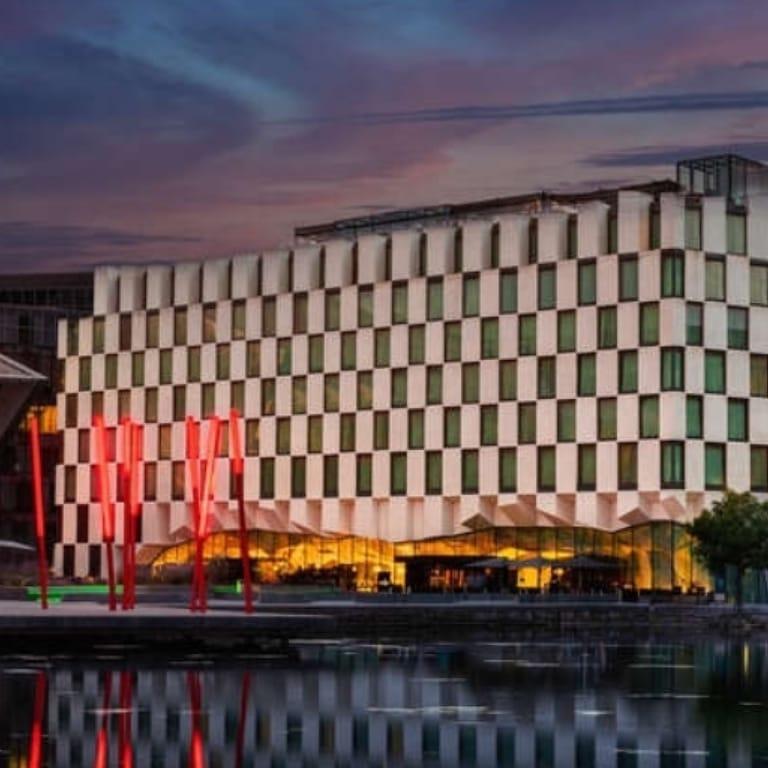The famine memorial in dublin: a poignant tribute to history and resilience.
Nestled along the scenic Custom House Quay in Dublin's lively Docklands, the Famine Memorial stands as a powerful and moving homage to one of Ireland's most harrowing chapters: the Great Irish Famine of the mid-19th century. This outdoor exhibit features a series of life-sized bronze statues sculpted by the acclaimed Irish artist Rowan Gillespie. These hauntingly realistic figures, including emaciated men, women, children, and even a dog, vividly portray the hardship, starvation, and heartache endured by over a million Irish citizens during the famine years of 1845 to 1852.
Visitors to this remarkable memorial often find themselves deeply moved, with many spending reflective moments absorbing the raw emotion captured in these bronze sculptures. The memorial is not only a tribute to those who suffered and perished but also a reminder of the resilience and enduring spirit of the Irish people. Situated just 20 minutes on foot from Dublin's bustling city center, the site is easily accessible and open to the public free of charge, making it an essential stop for history buffs, cultural enthusiasts, and travelers seeking meaningful experiences in Ireland’s capital.
exploring the memorial and its surroundings
Located along the picturesque River Liffey, the Famine Memorial is part of Dublin’s vibrant North Wall neighborhood, an area rich with history and modern urban charm. The Docklands area blends historic architecture with contemporary developments, offering visitors a chance to explore nearby attractions, cafes, and waterfront promenades. Whether you come to learn about Ireland’s past or simply enjoy a contemplative stroll by the river, the memorial’s setting enhances its emotional impact and invites quiet reflection.
why the famine memorial matters today
The Great Irish Famine was a devastating social crisis that reduced Ireland’s population by roughly 20–25%, through death and mass emigration. The Famine Memorial serves as a vital reminder not only of this tragic history but also of ongoing global issues such as hunger and displacement. By connecting the past to present-day struggles, the memorial encourages empathy and awareness worldwide, ensuring that the lessons of history continue to resonate.
- Free and open access 24/7 - Visitors can explore the memorial at any time without admission fees.
- Designed by Rowan Gillespie - The memorial’s bronze figures are the work of a notable Irish sculptor.
- Historical significance - Commemorates the suffering and resilience of the Irish people during the famine years.
frequently asked questions about the famine memorial
- What is the Famine Memorial in Dublin? The Famine Memorial is a series of life-sized bronze sculptures by artist Rowan Gillespie, located along Custom House Quay in Dublin's Docklands. The statues depict emaciated figures, symbolizing the suffering during the Great Irish Famine of the mid-19th century.
- Is there an admission fee to visit the Famine Memorial? No, the Famine Memorial is free to visit and open 24/7.
- Where is the Famine Memorial located? The Famine Memorial is situated along Custom House Quay in Dublin's Docklands area, near the River Liffey.
- Who designed the Famine Memorial? The Famine Memorial was designed by Irish sculptor Rowan Gillespie.
- What does the Famine Memorial commemorate? The Famine Memorial commemorates the Great Irish Famine of the mid-19th century, during which approximately one million people died and another million emigrated from Ireland.
community sentiment and visitor reflections
The Famine Memorial resonates deeply with visitors from around the world, who often describe it as a profoundly emotional and thought-provoking experience. Many praise the memorial's ability to convey the pain and isolation of the famine through its evocative sculptural forms, while also honoring hope and endurance amid despair. The memorial has become a significant cultural landmark in Dublin, widely regarded as essential for understanding Irish history and the global impact of famine and migration.
Whether you’re a history enthusiast, a traveler seeking meaningful sites, or someone interested in cultural heritage, the Famine Memorial invites you to pause and reflect on the resilience of the human spirit.
Discover this unforgettable Dublin landmark and connect with a pivotal story that continues to shape Ireland and its diaspora today.






